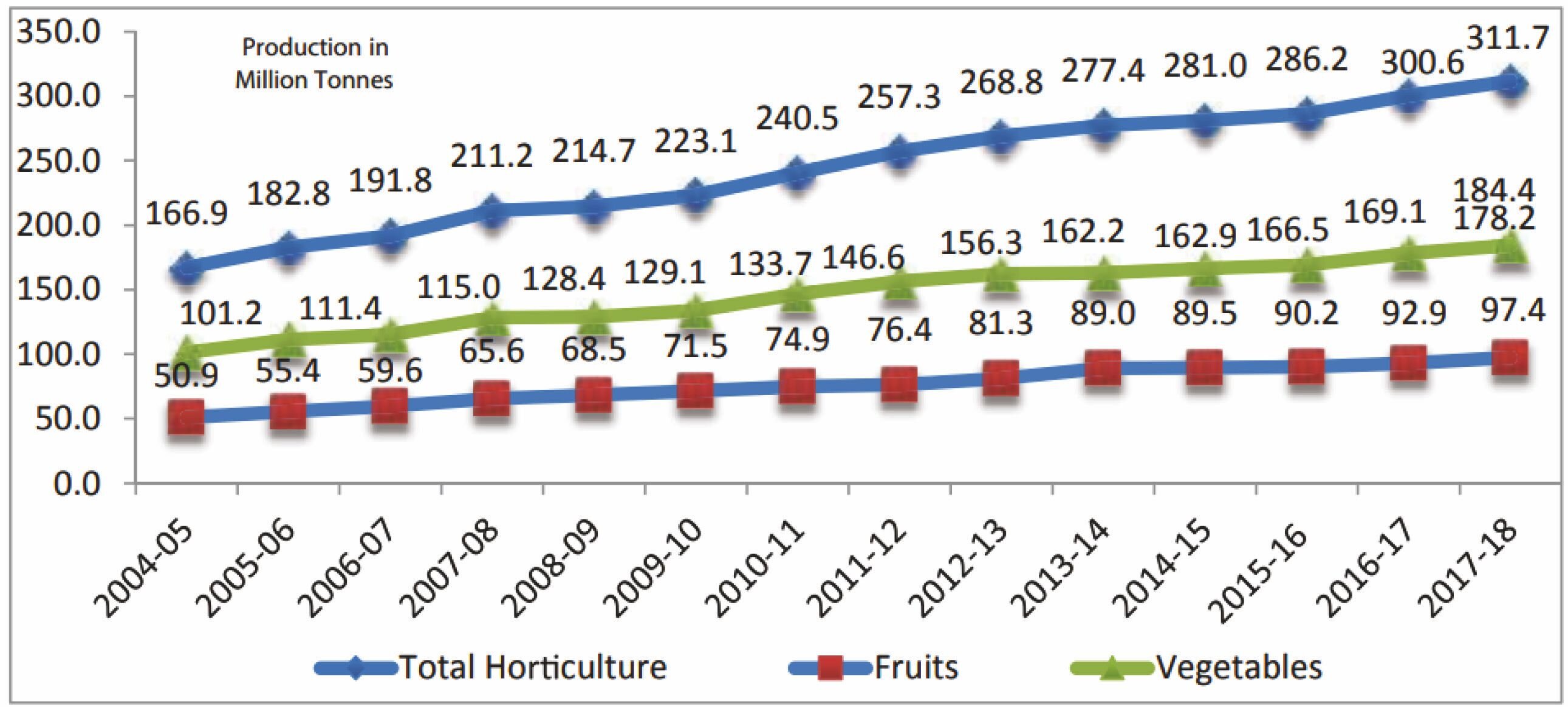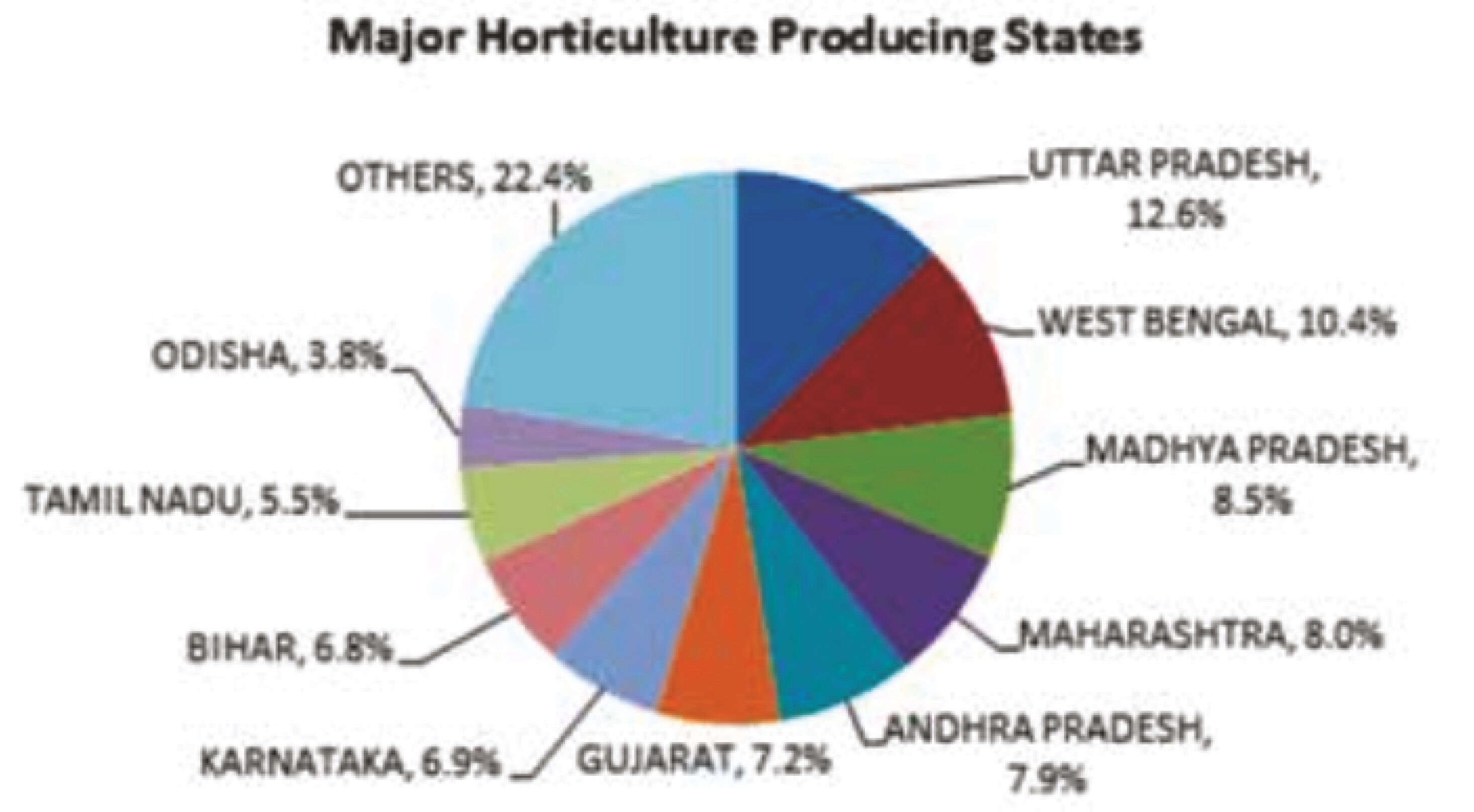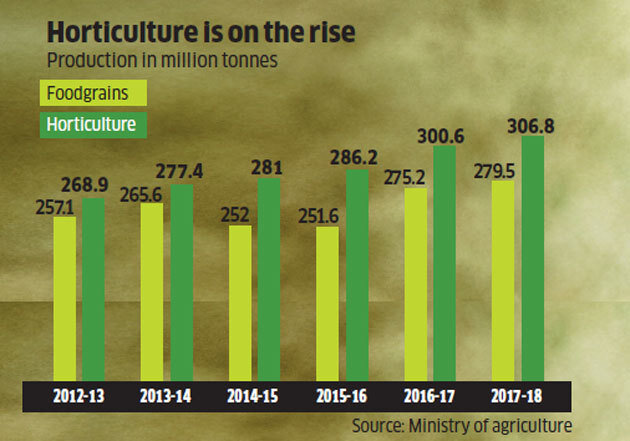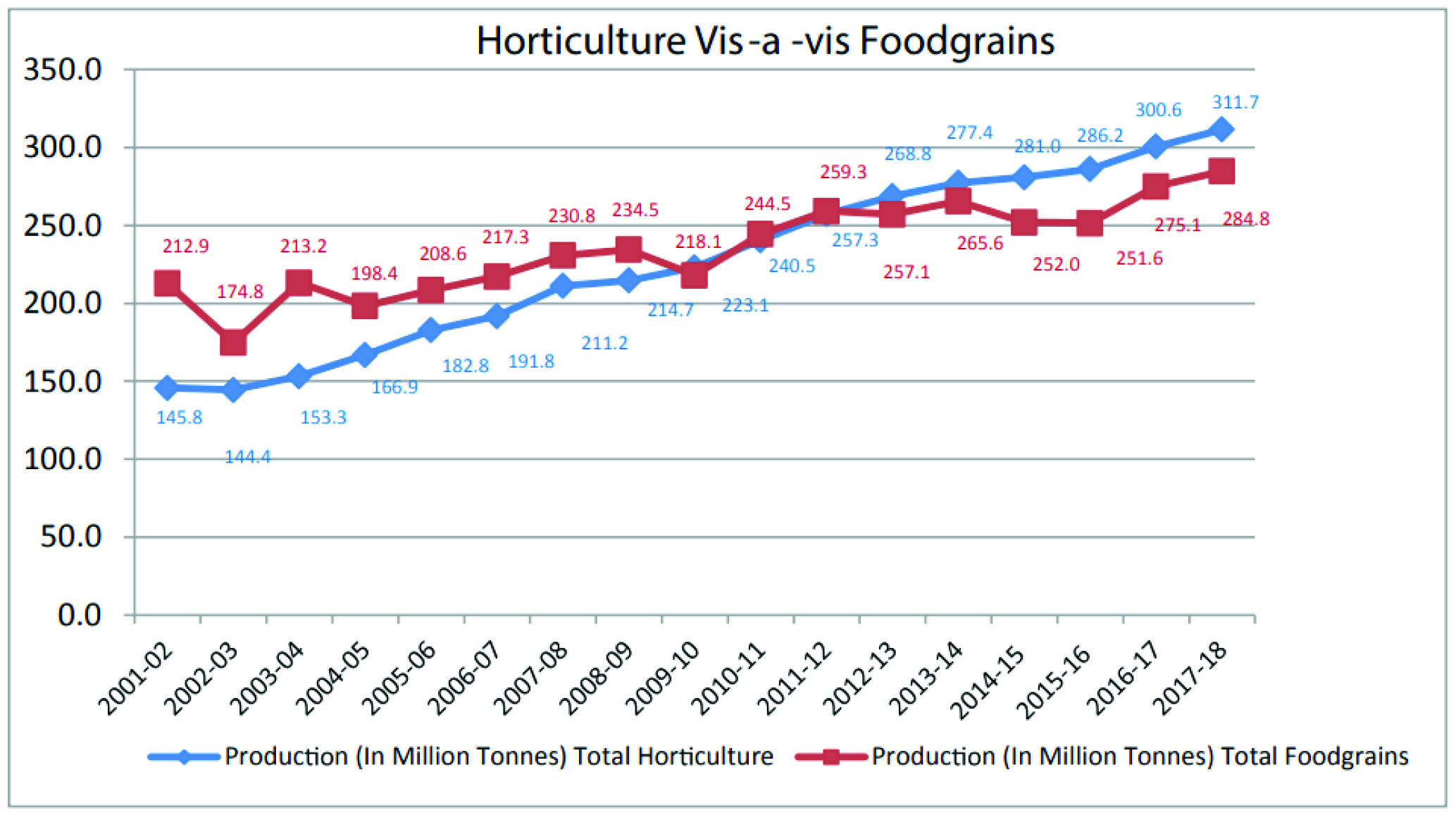Horticulture Sector in India | 23 Sep 2019
Why in News?
- Recently, Department of Agriculture, Cooperation and Farmers Welfare released the Third Advanced Estimate (2018-19) of Area and Production of various Horticulture Crops.
- As per the report, the total horticulture production in the country is estimated to be 313.85 million tonnes which is 0.69% higher than the horticulture production of 311.71 million tonnes in 2017-18.
- The area under horticulture crops has increased to 25.49 million hectares in 2018-19 from 25.43 million hectares in 2017-18.
The Department of Agriculture, Cooperation & Farmers Welfare (DAC&FW) is one of the three constituent departments of the Ministry of Agriculture & Farmers Welfare, the other two being Department of Animal Husbandry, Dairying & Fisheries (DAHD & F) and Department of Agricultural Research and Education (DARE).
What is Horticulture?
- Horticulture is the branch of agriculture concerned with intensively cultured plants directly used by man for food, medicinal purposes and aesthetic gratification.
- In simpler words, it is cultivation, production and sale of vegetables, fruits, flowers, herbs, ornamental or exotic plants.
- The term Horticulture is derived from the Latin words hortus (garden) and cultūra (cultivation).
- L.H. Bailey is considered the Father of American Horticulture and M.H. Marigowda is considered the Father of Indian Horticulture.
Classification
- Pomology: Planting, harvesting, storing, processing, and marketing of fruit and nut crops.
- Olericulture: Producing and marketing vegetables.
- Arboriculture: Study, selection and care of individual trees, shrubs or other perennial woody plants.
- Ornamental Horticulture: It has two subparts-
- Floriculture: Production, use and marketing of floral crops.
- Landscape Horticulture: Production and marketing of plants used to beautify the outdoor environment.
Features of Horticulture in India
- Horticulture sector has become one of the major drivers of growth as it is more remunerative than the agricultural sector (food grains mainly).
- This sector provides employment possibilities across primary, secondary and tertiary sectors.
- Horticulture crops, fruits are more resilient to change in weather conditions and the vegetables augment the income of small and marginal farmers.
- Water utilisation is very low, minimising the risk of crop failure and it can be done on smaller farms.
- Multiple crops are planted simultaneously to get more yield and to use the maximum of the fertilisers.
- This sector enables the population to eat a diverse and balanced diet for a healthy lifestyle.
- It became a key driver for economic development in many of the states in the country where Division of Horticulture of Indian Council of Agricultural Research is playing a pivotal role.
Indian Council of Agricultural Resource (ICAR)
- An autonomous organisation under the Department of Agricultural Research and Education (DARE).
- Formerly known as Imperial Council of Agricultural Research, it was established on 16 July 1929.
- Headquartered at New Delhi.
- It is the apex body for coordinating, guiding and managing research and education in agriculture including horticulture, fisheries and animal sciences in the entire country.
Achievements
- In the last few decades, this sector has gained prominence over contributing a growing share in Gross Value Addition of the Agriculture and allied sectors.
- Mission for Integrated Development of Horticulture (MIDH) is being implemented by adopting an end to end approach for increasing production of horticulture crops and reducing post-harvest losses.
Mission for Integrated Development of Horticulture (MIDH)
- Centrally Sponsored Scheme for the holistic growth of the horticulture sector covering fruits, vegetables and other areas.
- Under MIDH, Government of India contributes 60% of the total outlay for developmental programmes in all the states (except North Eastern and Himalayan states where GOI contributes 90%) & 40% is contributed by State governments.
- It has five major schemes on horticulture-
- National Horticulture Mission (NHM)
- Horticulture Mission for North East and Himalayan States (HMNEH)
- National Horticulture Board (NHB)
- Coconut Development Board (CDB) &
- Central Institute of Horticulture (CIH), Nagaland
National Horticulture Board (NHB)
- It was set up in 1984 on the basis of recommendations of the "Group on Perishable Agricultural Commodities", headed by Dr M. S. Swaminathan.
- Headquartered at Gurugram.
- Objective is to improve integrated development of Horticulture industry and to help in coordinating, sustaining the production and processing of fruits and vegetables.
- The production of fruits and vegetables has overcome the production of food grains in the country.
- The total horticulture production has increased from 211.2 million tonnes in 2007-08 to 311.71 million tonnes in 2018-19.
- India is the second largest producer of fruits and vegetables in the world with first rank in the production of Banana, Mango, Lime & Lemon, Papaya and Okra.
Horticulture Statistics at a Glance- 2018
- Important publication of the Ministry of Agriculture and Farmers Welfare.
- The Horticulture Statistics Division in the Department of Agriculture, Cooperation and Farmers’ Welfare has taken various initiatives to improve the database of horticulture crops.
- Horticulture Area Production Information System (HAPIS) is a web enabled information system by which data from the states/districts is reported, minimising the time-lag and maximising the coverage area.
- Coordinated programme on Horticulture Assessment and MANagement using geoinformatics (CHAMAN) with the objective to develop & firm up scientific methodology for estimation of area & production under horticulture crops through Remote Sensing and Sample Survey Techniques.
- The varieties tolerant/resistant to various biotic and abiotic stresses have been developed in different fruits, vegetables, medicinal and aromatic plants.
- Improved techniques for production of disease free quality planting materials have been developed. Micro propagation techniques have been standardized for various fruits, spices and other vegetatively propagated plants.
- Technology for enhancing the water and nutrient efficiency through micro irrigation and fertigation has been developed for a number of horticultural crops.
- Good Agricultural Practices (GAP) are developed for various plants, especially medicinal.
- Farm mechanization to increase harvesting and processing efficiency and to reduce crop loss has been implemented by developing horticulturalists.
- Low cost environment friendly cool chamber was developed for on-farm storage of fruits and vegetables.
- For dissemination of technologies, region and crop specific training and demonstration programmes are being taken up.
Challenges
- Horticulture does not enjoy a safety net like the Minimum Support Price (MSP) for foodgrains.
- Lack of good cold chain storage and transport networks to extend the life of perishable products.
- Very less or limited input by machinery and equipment so it is tough to minimise the time restraints.
- Higher input costs than foodgrains make it a difficult set up, especially when there is no support from the local governments to the smaller farmers.
- It gets challenging for marginal farmers to cope with the high price fluctuations.
- Limited availability of market intelligence, mainly for exports makes it a tougher option to choose.
Suggestions
- Achieve technology led development in Horticulture.
- Post harvest & value addition in horticulture crops.
- Modified atmosphere packaging for long storability & transportation of fruits & vegetables.
- Insect pollinators for improving productivity and quality of the crops.
- Development of varieties for cultivation in non-traditional areas.
- Nutrient dynamics and interaction.
- Bioenergy and solid waste utilisation to make horticulture more efficient and eco-friendly.
- Plan, coordinate and monitor R&D programmes at national level as well as to serve as knowledge repository in Horticulture sector.
Way Forward
- The diversification in the agricultural sector mainly of the horticulture sector has become a major source of positive growth for the sector itself and for the nation.
- It has emerged as a promising source of income acceleration, employment generation, poverty alleviation and export promotion.
- India can emerge as a far bigger producer and exporter if sufficient emphasis is given to resource allocation, infrastructure development, more R&D, technological upgradation and better policy framework for horticulture sector.
- Horticulture sector with strong forward and backward linkages as an organised industry can stimulate and sustain growth.




